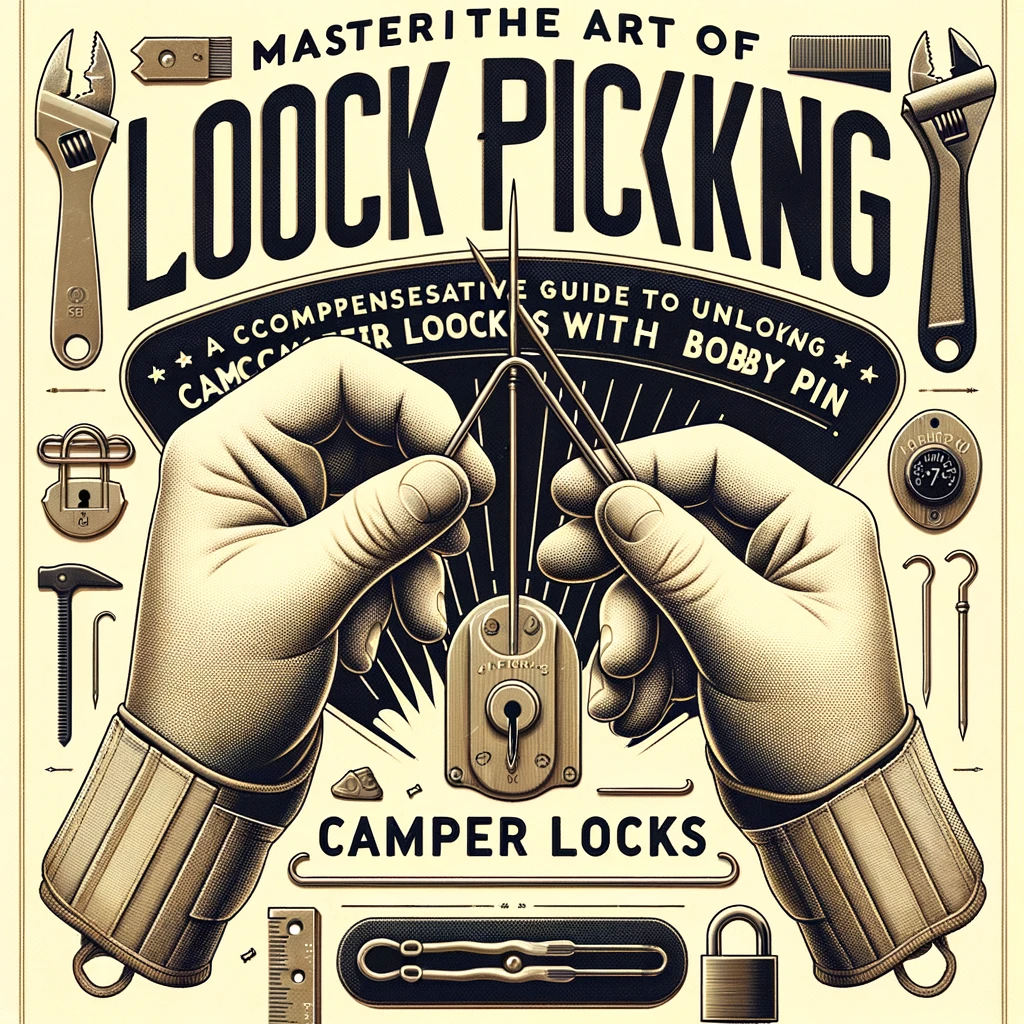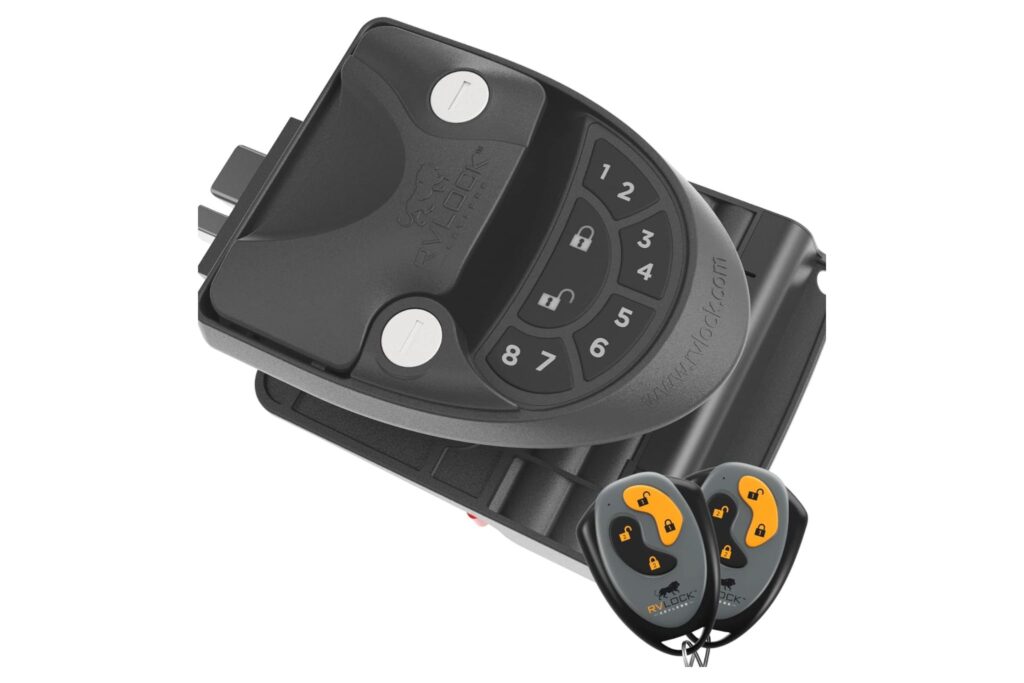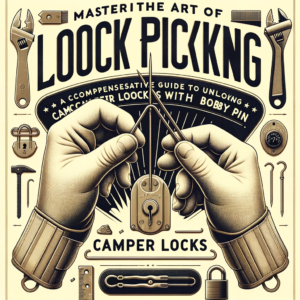
Envision the following situation: your camper is ready for a weekend excursion, but you’re locked out and don’t have a spare key with you. Although it may appear hopeless, there is a very easy fix: a bobby pin. With the help of this comprehensive instruction, you will be able to choose a camper lock by using this everyday home object. We’ll also look at several lock-picking methods and discuss the moral and legal implications of this useful talent.
Table of Contents
How to Pick a Camper Lock with a Bobby Pin
Using bobby pins, pick a camper lock by following these comprehensive instructions from several sources:
Step 1: Create The Tension Tool and The Pick Tool*
1. Make a Lever Tension Tool: To use one bobby pin as a tension wrench or lever, bend it into a ‘L’ shape. Applying pressure to the lock mechanism is essential with this tool.
2. Make a Selection: Insert a second bobby pin into a long piece of metal wire that has a small bend at the end. The curve will be used to manipulate the pins inside the lock. The flat side of the bobby pin should face upwards.
Step 2: Insert the Tension Tool and Apply Pressure
- Tension tool insertion: Insert the bent end of the tension tool (lever) as deeply as possible in the lower half of the keyhole.
- Apply Pressure: Apply light pressure while twisting the tension tool in a small, key-like motion. It is important to keep this pressure constant throughout the procedure. Refrain from applying too much pressure to avoid breaking the lock or blocking the pins.
Step 3: Insert the Pick and Feel the Pins
- Insert the Pick: Hold the pick with its bent side facing up and place it above the tension tool. To feel the pins inside the lock, gently slide the pick up and down.
- Identify Pin Movement: Ascertain which pins are jammed and which are free to move. Reduce the tension on the tension tool if none move; otherwise, it may be excessively tight.
Step 4: Locate and Move the Jammed Pin
- Identify the Jammed Pin: Touch the pin that is hard to loosen. You should concentrate on this pin first .
- Push the Pin: Press the stuck pin upward with the pick until you hear a click, while continuing to apply pressure on the tension tool. The pin is appropriately positioned, as shown by this sound.
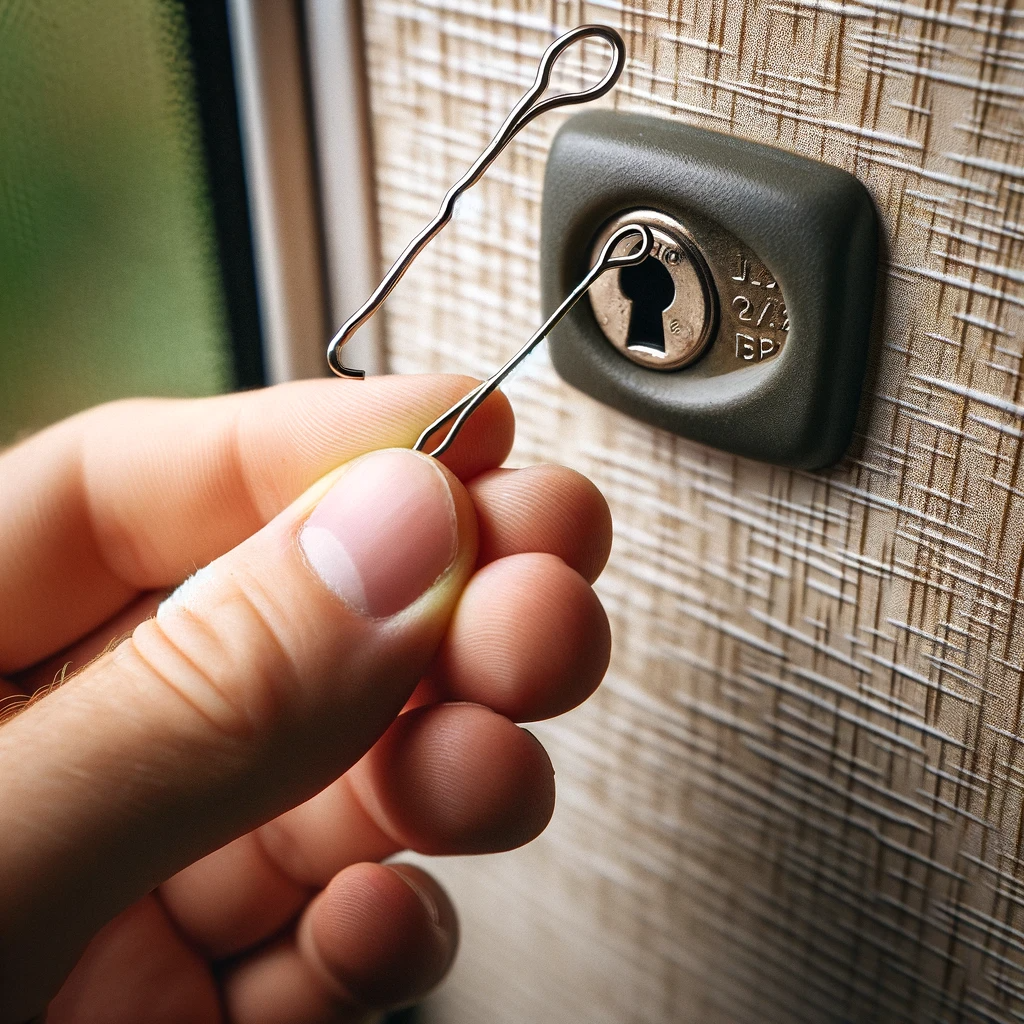
Step 5: Repeat for Other Pins
- Repeat the Procedure: Other pins can block up after you’ve set one. Using the same technique, keep finding and setting these pins.
- Let the lock open: The tension tool should be able to rotate completely after all pins are in place, unlocking the lock.
Recall that you should only use these instructions on locks that you own or have permission to pick. They are meant only as teaching tools. It is against the law and unethical to use these methods on unapproved locks. In order to prevent breaking the lock, it’s also a good idea to get in touch with a professional locksmith if you’re not sure you can pick a lock.
Lock Picking Basics: Understanding Your Camper Lock
There are several different types of camper locks, and each has a different mechanism.
1. Locks for disc detainers: Instead of pins, these locks use slotted rotating discs. To open the lock, each disc must be turned to a precise position. Such a lock’s key features notches that line up with each disc’s proper rotation.
2. Wafer Locks: Wafer locks replace pin stacks with flat, single-piece wafers. The lock may turn because the key moves these wafers into the proper alignment at the shear line.
3. Tumbler Locks with Pins: These locks operate with a set of pins that, as previously mentioned, must line up at the shear line in order for the lock to open. To accomplish this alignment, the key raises the pins to the proper height.
Principles of lock picking:
Simulating the key’s operation is the basic idea behind lock picking. The objective of all these lock kinds is to spin and unlock the lock by manipulating the internal mechanism—whether it be made of discs, wafers, or pins—without using the original key. To do this, you typically need to apply the proper amount of tension, pay attention to the lock’s feedback as you operate it, and move the pick carefully to configure the locking mechanism appropriately.
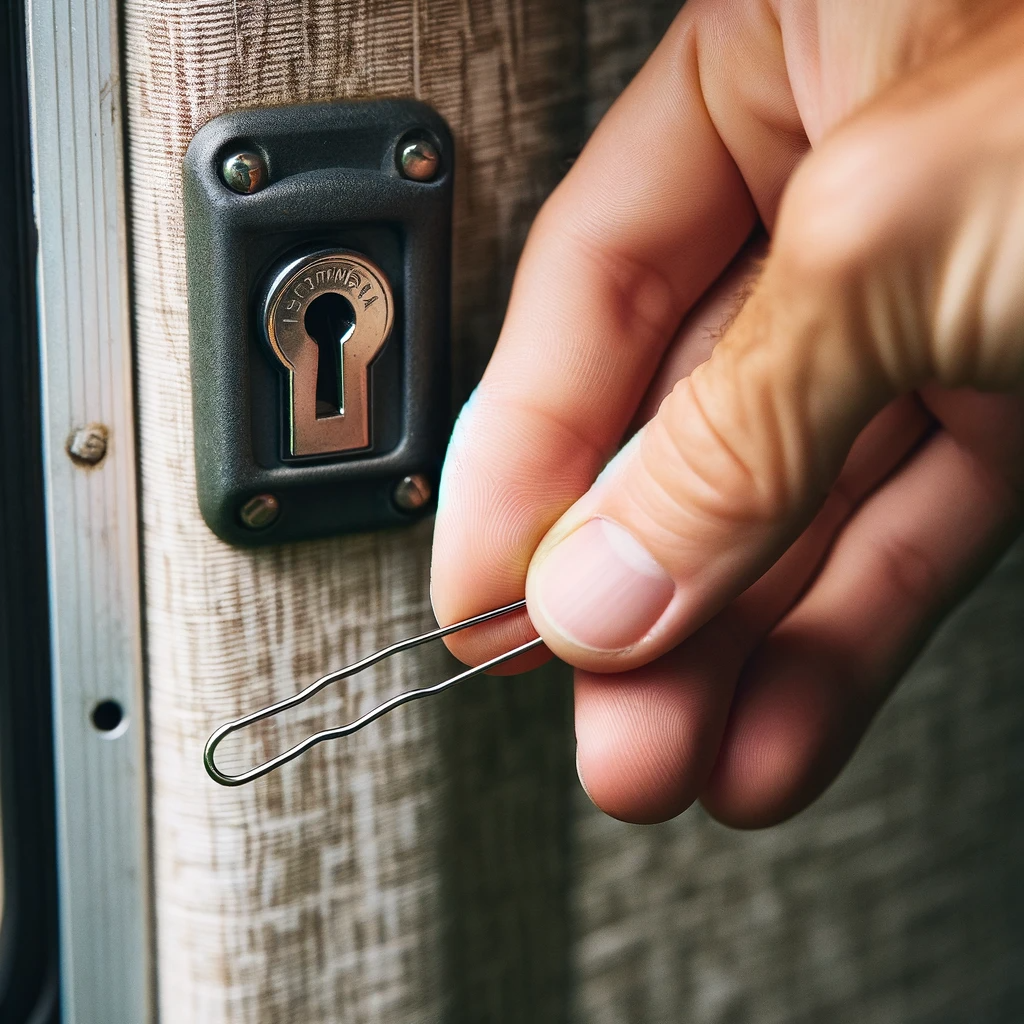
The Bobby Pin: A Lock Picker's Unexpected Ally
When getting ready to pick a lock with a bobby pin, find one that is robust but flexible; stay away from pins that are too thin or hard. Completely straighten the bobby pin, then bend the little hook on one end to facilitate working with the pins within the lock. Using a second bobby pin to form a ‘L’ shape, use the tension wrench to impart rotational torque to the lock. Using a little pressure similar to turning a key, insert the tension wrench into the lower portion of the keyhole, being careful to adjust the pressure based on the response from the lock. This guarantees that the pins are properly positioned and won’t jam. Bobby pins with rubber tips should be avoided since they may impede the movement of the lock.
Comprehensive Guide: Picking a Camper Lock with a Bobby Pin
Positioning and Inserting the Bobby Pin:
– pin-tumbler locks, insert the tension wrench (L-shaped bobby pin) into the bottom of the keyhole and apply slight rotational pressure. Then, insert the pick (hooked bobby pin) into the top of the keyhole.
– wafer locks, use a similar approach but be mindful of the wafer’s positions; they require a more nuanced touch.
– disc detainer locks**, the process is more complex and might not be feasible with just a bobby pin due to the need for rotational manipulation of the discs.
Manipulating the Lock Mechanism:
– Use the pick to feel and push the pins up to the shear line in pin-tumbler locks, or manipulate the wafers in wafer locks. The goal is to align all pins or wafers at the shear line simultaneously while maintaining tension with the wrench.
– With each correct setting of a pin or wafer, you may feel a slight movement in the tension wrench, indicating progress.
Practical Exercises:
– Start with simpler locks, such as basic padlocks or door locks, to practice feeling and setting each pin.
– Increase complexity gradually, moving to locks with more pins or different mechanisms.
– Patience and attention to the subtle feedback from the lock are crucial in these exercises.
Remember, these skills should only be used legally and ethically, and practice should be done on locks you own or have permission to pick.
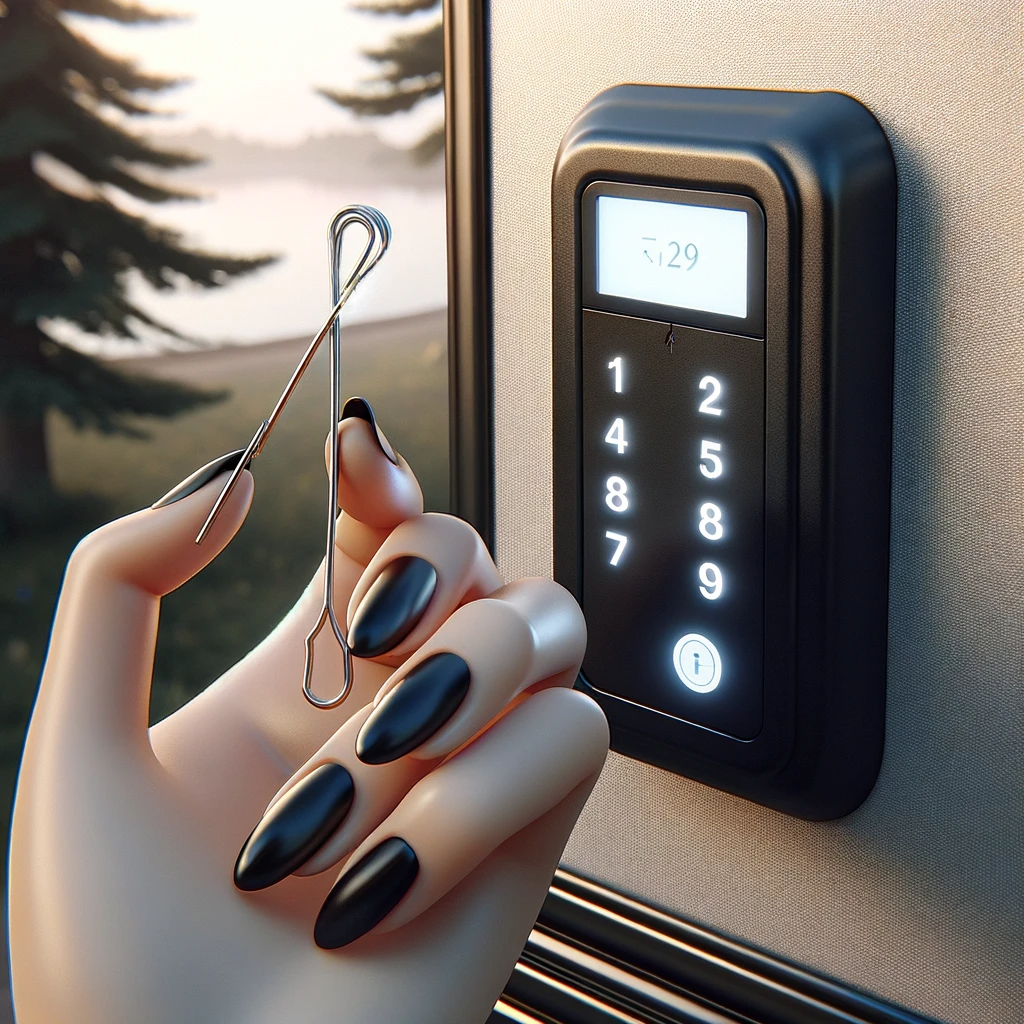
Beyond Bobby Pins: Other DIY Lock Picking Tools
In lock picking, alternative tools like paper clips, pencils, and safety pins can be utilized in place of traditional lock picking tools. Paper clips are particularly useful as they can be easily straightened and bent to form picks and tension tools, similar to bobby pins. Pencils, while not typically used as picks, can sometimes be employed to apply tension in less complex locks thanks to their rigid ends. Safety pins, due to their sturdy structure, are also viable as picks. However, their smaller size might pose a challenge when working with certain locks. These improvised tools offer versatile solutions in situations where conventional lock picking tools are not available.
Improvising Tools:
– When standard tools like picks and tension wrenches aren’t available, look for sturdy, thin metal objects that can be bent and inserted into a lock.
– Items like small screwdrivers, wire coat hangers, or even the metal strips inside windshield wiper blades can be fashioned into crude lock-picking tools.
– The key is to find something that can both fit into the keyhole and be manipulated to move the locking mechanism without breaking.
Mastering Different Types of Locks: From Pin Tumblers to Circle Locks
Pin tumbler lock techniques:
– Pay close attention to locating and accurately positioning each pin. Tension can be applied with the tension wrench and each pin can be carefully lifted with the pick.
– As each pin sets at the shear line, listen and feel the tension wrench for any clicks or little movements.
Difficulties with Circle Locks:
– Tools capable of navigating its rounded shape are necessary for circular or tubular locks. Ordinary bobby pins might not work well.
– Usually, specialized tubular lock picks that can simultaneously press all the pins are required.
Managing Locks with High Security:
– Security pins (spool, serrated, or mushroom pins) are examples of anti-picking features included in high-security locks that make them more difficult to pick.
With these locks, you have to be more deft and skilled in order to move the security pins without having to reset the lock altogether.
– Due to their complexity, high-security locks frequently require professional assistance.
The Ethics and Legality of Lock Picking
Legal Considerations:
– The legality of possessing lock picking tools and engaging in lock picking varies by region. In some places, possession without licensure or proof of locksmith training can be considered suspicious or even illegal.
– In many jurisdictions, using lock picking tools on property that isn’t yours, or without explicit permission, is illegal and can be considered as breaking and entering or burglary.
Ethical Practices:
– Ethical lock picking adheres to the philosophy of only picking locks that you own, or for which you have received explicit permission to pick.
– Respecting privacy and property rights is paramount. Even if you possess the skills to pick a lock, using them without consent violates trust and privacy.
– Lock picking should be viewed as a skill for personal enrichment or professional use, not for unauthorized access to spaces or property.
When DIY Fails: Seeking Professional Help
Recognizing Your Limits:
– Understanding your skill level is crucial in lock picking. If you’re unable to pick a lock after several attempts, or if the lock is of a high-security type, it’s time to consider calling a professional locksmith.
– Attempting to force a lock open can cause damage, making the situation worse. If you feel out of depth or if the lock mechanism feels overly complex, it’s best to stop and seek professional help.
Finding a Reputable Locksmith:
– Research and choose a locksmith with good reviews and a strong reputation. Websites and local forums can be good sources for reviews.
– Ensure the locksmith is licensed and insured. A reputable locksmith should have credentials and be willing to show them upon request.
– Ask for a clear estimate before work begins. A trustworthy locksmith will provide a detailed quote including service fees, replacement parts costs, and labor charges.

Preventing Future Lockouts: Practical Tips and Strategies
Key Management:
– Implement a systematic approach for organizing and storing spare keys. This can involve using key safes, labeling keys, or entrusting a set to a reliable neighbor or family member.
– Consider digital solutions like key tracking apps or key rings with Bluetooth trackers to keep track of key locations.
Upgrade Options:
– Keyless entry systems, like smart locks, offer a modern solution to avoid lockouts. These systems can be operated via smartphones, codes, or biometrics, providing a higher level of convenience and security.
– Investigating smart home integration for locks can also provide remote access and control, further reducing the likelihood of lockouts.
Advanced Lock Picking Techniques for Enthusiasts
Complex Lock Picking Methods:
– Learning more complex lock picking techniques, such as raking, single pin picking, and utilizing various tension levels (light, variable), is crucial for people who want to get more involved in the hobby. It’s also essential to comprehend the subtle differences between spool, mushroom, and serrated security pins in high-security locks.
– Expanding one’s skill set involves practicing on a range of lock types, such as wafer locks, disc detainer locks, and dimple locks.
How to Assemble a Lock Picking Kit:
– Different picks (hooks, rakes, and diamonds), tension wrenches (varying sizes and flexibilities), and practice locks should all be included in a thorough kit.
– Specialty equipment like bump keys, a pick gun, or tubular lock picks may also be used by advanced pickers. Additionally helpful are a lubricant and magnifying glass.
– Tools may be efficiently maintained and transported when they are organized in a portable case.
Lock Maintenance: Ensuring Security and Durability
Maintaining camper locks involves routine cleaning and lubrication with graphite-based products to prevent wear and sticking. Regular inspections should be conducted to identify and address signs of wear, damage, or loose components. Keeping keyholes clear of dirt and debris ensures smooth operation of the lock and key. Troubleshooting common issues includes checking for obstructions or misalignments when a key doesn’t turn, lubricating locks that are stuck, and tightening loose hardware. For complex problems, consulting with a professional locksmith is advisable to ensure proper functioning and security of the lock system.
Psychological Aspects
Lock picking is a mental game that calls for certain abilities like focus, perseverance, and problem-solving. These skills are necessary to operate lock systems properly, particularly in intricate or high-security locks. Furthermore, lock picking is a hobby that helps people decompress. People are able to focus deeply on the activity due to its detailed and engaging nature, which helps them detach from daily concerns and gives them a sense of accomplishment and relaxation. For many fans, lock picking is a unique and fulfilling hobby since it combines brain stimulation with stress release.
Last Verdict
In summary, the key points covered in the guide include understanding different types of camper locks (pin-tumbler, disc detainer, wafer locks) and the basic principles of lock picking. We discussed how to select and fashion tools like bobby pins for lock picking, and the importance of feeling for pins and applying the correct tension. The guide also emphasized the need for ethical practices in lock picking, highlighting that it should only be used on locks you own or have permission to pick. Regular maintenance of locks and troubleshooting common issues were also covered. Ultimately, while lock picking is a valuable skill, it’s crucial to practice it responsibly and ethically, respecting privacy and legality at all times.
Mustakim Hasan
As an engineer with a keen eye for detail, I combines their technical expertise with a fervent passion for the outdoors. At bestcampgears.com, I share in-depth reviews on the latest camping, outdoor, and sports products, offering readers valuable insights and reliable recommendations. Drawing from personal experiences and a love for nature, I also provides practical tips, tricks, and guidance to enhance your outdoor adventures. Whether you're a seasoned camper or a budding outdoor enthusiast, [Your Name]'s blog is your go-to resource for all things camping and outdoors.
why do irish travellers dress provocatively ?
Irish Travellers, often known simply as Travellers, represent a distinct...
Read MoreUnlocking the Mystique: What is a Colorado Campfire?
In today’s rapidly evolving linguistic landscape, urban slang continually presents...
Read MoreUnlocking Adventures: A Step-by-Step Guide on How to Pick a Camper Lock with a Bobby Pin
Envision the following situation: your camper is ready for a...
Read MoreUltimate Guide to Choosing the Best Camp Bunk Beds for Your Outdoor Adventures – 2024
Are you preparing a camping trip and want to make...
Read More